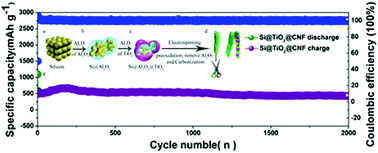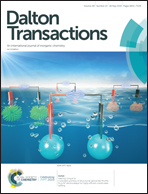A carob-inspired nanoscale design of yolk–shell Si@void@TiO2-CNF composite as anode material for high-performance lithium-ion batteries†
Abstract
Silicon (Si) is an attractive anode material for lithium-ion batteries due to its high gravimetric and volumetric capacity. However, the challenges for Si anodes are low conductivity, unstable solid electrolyte interphase (SEI) layer and big volume expansion during the charge/discharge process. Inspired by the structure of carob, we propose a yolk–shell structured Si anode which tackles all the problems mentioned above. The non-filling Si clusters protected by atomic layer-deposited TiO2 are embedded in highly conductive one-dimensional carbon nanofibers, which leaves enough space for the expansion and contraction of Si during lithiation/delithiation. Moreover, the SEI layer will form at the outer surface of carbon nanofibers instead of on individual Si nanoparticles and can remain stable and spatially confined. Therefore, the yolk–shell composite electrode exhibits good electrochemical performance and reversible capacities of 1156 mA h g−1 at a current density of 600 mA g−1 after 500 cycles and 485 mA h g−1 at the current density of 9600 mA g−1 after 2000 cycles are obtained.



 Please wait while we load your content...
Please wait while we load your content...